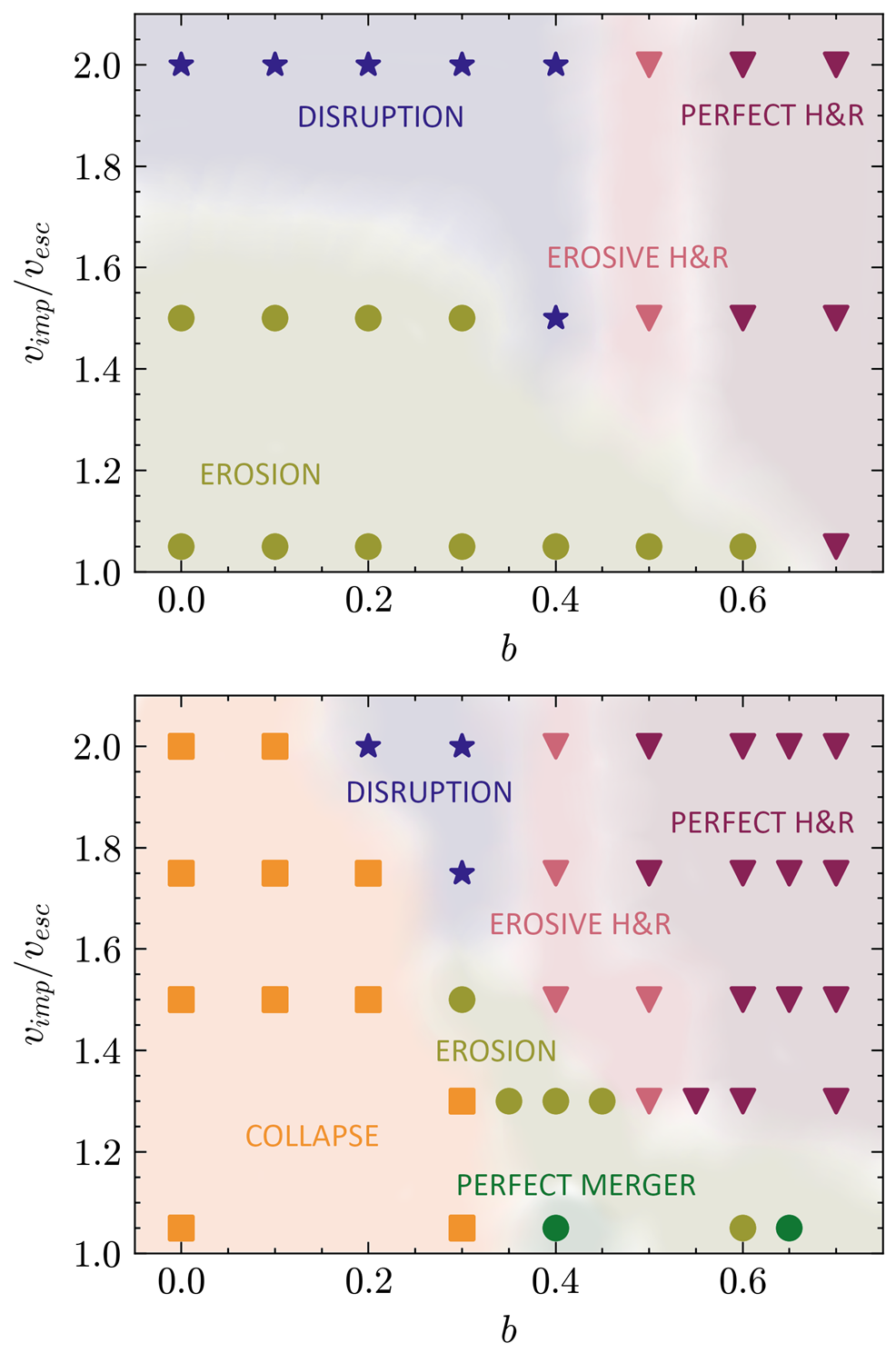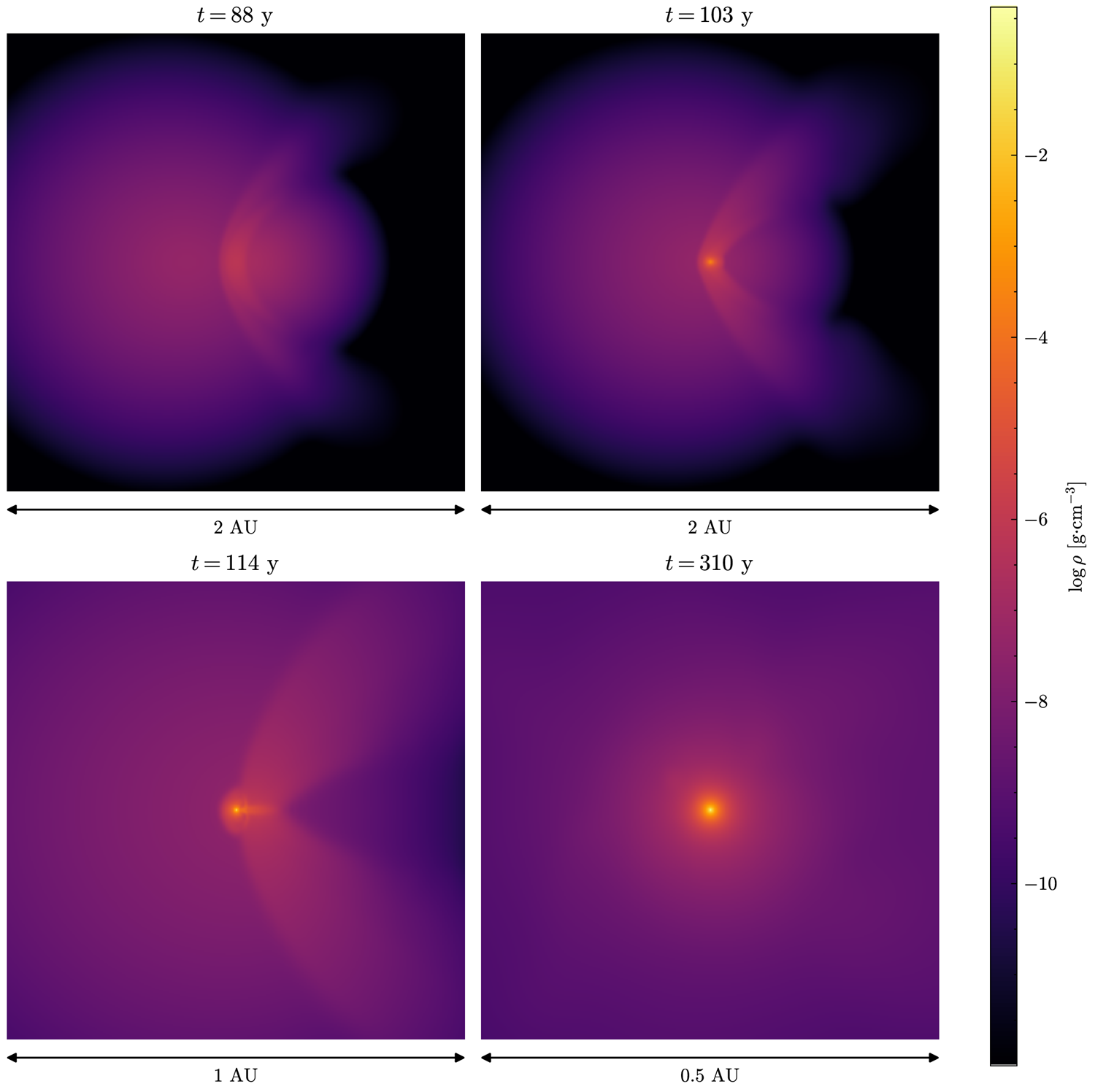The Outcome of Collisions between Gaseous Clumps formed by Disk Instability
- 1University of Zürich, Department of Astrophysics, Faculty of Science, Switzerland (christian.reinhardt@uzh.ch)
- 2University of Bern, Space Research and Planetary Sciences, Physics Institute, Switzerland
Introduction: The formation of giant planets is a fundamental open question in planetary science. According to the disk instability (DI) model, the formation of giant planets starts with the proto-planetary disk becoming locally gravitationally unstable and fragmenting into cold and extended gaseous clumps. These clumps are expected to have masses of a few times the Jovian mass (MJ) and radii of hundreds to thousands of Jupiter radii (RJ) which makes them susceptible to disruption. The clumps then slowly contract over 104 - 106 years (pre-collapse stage) until hydrogen (H) dissociation initiates a rapid dynamic collapse during which they rapidly contract to a few RJ, leading to the formation of protoplanets. One key ingredient of such models are the gravitational interaction of clumps due to collisions. For simplicity, collisions are modeled assuming point mass for the clumps and any collision is assumed to lead to perfect merging between clumps. These assumptions, however, are inappropriate for modeling clump collisions especially during the early stages of gravitational collapse when the clumps are very extended and are only weakly gravitationally bound.
Methods: We perform a large suite of 3D impact simulations between clumps during the pre-collapse stage with the novel Smoothed Particle Hydrodynamics (SPH) code pkdgrav3. The clumps are assumed to be made of a Hydrogen (H) and Helium (He) mixture in proto-Solar proportions which is modelled using a version of the SCvH EOS (Saumon et al. 1995) that was extended to the low temperatures occurring during the pre-collapse stage. We consider clump masses of 1, 3, 5 and 10 MJ and three different ages which correspond to different evolution time: after the clump becomes gravitationally bound (“young”), at the middle of the pre-collapse phase (“mid”) and before the dynamic collapse occurs (“evolved”). The density and temperature profiles of the clumps are guided by evolution simulations of isolated clumps during the pre-collapse stage (Helled & Bodenheimer, 2010). For each combination of clump mass and age we perform impact simulations at different impact angles and velocities. After each collision we determine the number of the remaining clumps, their masses and internal structure and classify the collision outcome (e.g., prefect merger, erosion, disruption or hit-and-run).
Results: We find that the outcomes of clump collisions are extremely diverse and range from perfect merging (PM), erosion and disruption to hit-and-run collisions (HRC) (see Figure 1). PM, as assumed in population synthesis models, are very rare, even for the most favorable conditions (i.e., massive, and relatively old and compact clumps). Clump collisions typically lead to mass loss and erosive and disruptive outcomes are very common. Disruption can already occur for impacts with rather low relative velocities of a few km/s due to the shallow gravitational potential of the clumps. Therefore this collision outcome is expected to be common even at large distances from the central star. For large impact angles and velocities, a transition to HRC occurs and both bodies survive the collision, exchanging mass and angular momentum. We also find that impacts can shorten the time to reach dynamic collapse over a wide range of impact conditions (Figure 2). This increases the survival probability of clumps since during the pre-collapse phase they are most susceptible to disruption. This in turn could have a substantial impact on the inferred population of giant planets in the disk instability model.
Conclusions: The outcomes of clump collisions are extremely diverse and the assumption of perfect merging often used in population synthesis models is rarely satisfied. Furthermore, collisions can initiate dynamic collapse, hence shortening the pre-collapse stage during which clumps are most likely to be disrupted. Our simulations show that population synthesis models must account for the diverse collision outcomes. In addition, it is clear that collisions between planetary clumps plays a key role in shaping the distribution of frequency, mass and orbital characteristics of planets in the disk instability model. Our study advances our understanding of planet formation and early evolution in the disk instability model and clearly shows the need to include realistic collisions outcomes in population synthesis models.

Figure 1: The diverse outcomes of collisions between young 3MJ (top) and evolved 10 MJ (bottom) clumps inferred from 3D impact simulations. Perfect merging which is assumed in population synthesis models is very rare and collisions often result in erosion / disruption of the clumps or hit-and-run encounters. Collisions can also accelerate the stage of dynamical collapse, hence shortening the pre-collapse stage during which clumps are most likely to be disrupted.

Figure 2: A head-on collision between evolved 10 and 5 MJ clumps occurring close to the mutual escape velocity. During the impact a compact region is forming behind the shock front in which the density increases by several orders of magnitude. At a later stage the collapsed region pierces through the shock front and regains hydrostatic equilibrium. After the collision 77% of the total colliding mass remains bound.
How to cite: Reinhardt, C., Helled, R., Matzkevich, Y., Meier, T., and Stadel, J.: The Outcome of Collisions between Gaseous Clumps formed by Disk Instability, Europlanet Science Congress 2024, Berlin, Germany, 8–13 Sep 2024, EPSC2024-290, https://doi.org/10.5194/epsc2024-290, 2024.